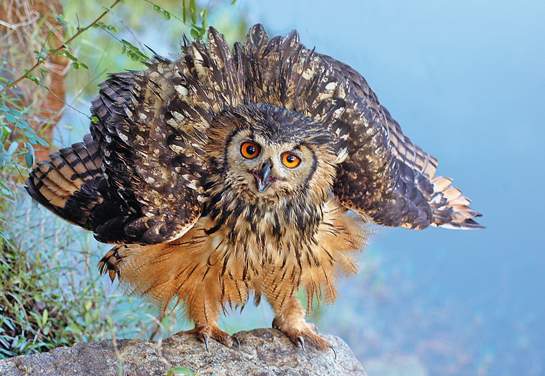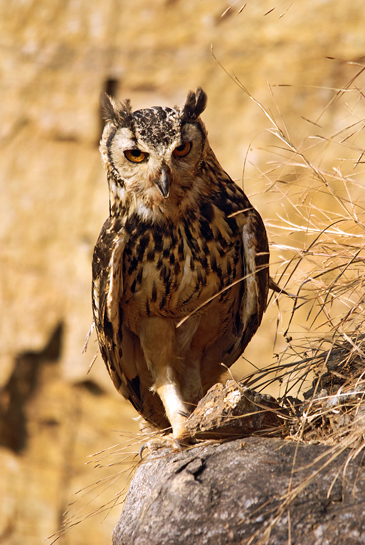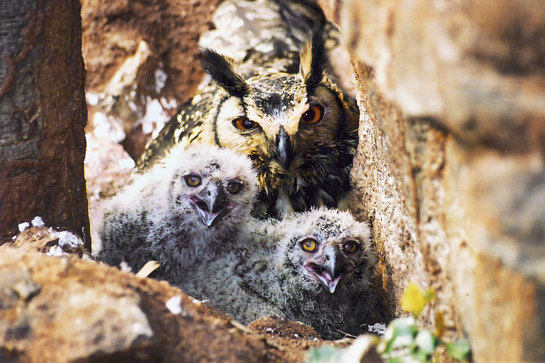Eurasian Eagle Owl or Indian Eagle Owl? How to Tell the Difference.
First published in Sanctuary Asia,
Vol. 35
No. 2,
February 2015
Eurasian Eagle Owl or Indian Eagle Owl? ‘Bubophile’ M. Eric Ramanujam helps Sanctuary readers figure out what sets the two apart.
Rauf Ali refers to me as a bubophile and coming from that source I do not actually know if it is a compliment or otherwise. Even if it is meant to be sarcastic it's okay since my friends have called me worse - owlholic, strigiomaniac, and ‘ullu ka patta' are some among the other unprintable ones. To most people who know me, I would seem to be living in a world of conundrums since I am not at all a birder (though I recognise most species of our region, waders are a nightmare). It is a fact that some of my friends who are keen birdwatchers are more than just upset with me due to my attitude and statements concerning their ‘hobby. But I find the Indian Eagle Owl Bubo bengalensis fascinating, and would love to spend all my time collecting data, reading up on the Strigiformes or Falconiformes, analyzing stuff - in fact, anything to unravel the natural history, especially the behavior of this fascinating taxon.
Maybe herein lies the fascination for owls - the simple knowledge that nearly nothing is known about the taxon's behavior. Behavioral ecology is a tricky term since there are few practitioners of the science of avian ethology in the country, and the thrill and gratification lie in unraveling secrets. Once a barrier has been broken down, a pattern emerges - in some ways science is akin to forensics.

Photo: A. Lakshmikantan.
So what is so fascinating about owls? EVERYTHING! But I'd like to begin with nomenclatural controversies and further conundrums.
The holotype described as Otus bengalensis by Major James Franklin and exhibited at the Zoological Society of London in 1830-1831 was alluded to be a variety of the Great-eared Owl by Dr. John Latham, the ‘grandfather of Australian ornithology. During the first half of the 20th century, the foremost champion of raptor taxonomy, Georgiy Petrovich Dementiev of Russia, considered it to be a “borderline case between species and subspecies", and though not conspecific, acknowledged that the Eurasian Eagle Owl Bubo bubo and Indian Eagle Owl were closely related. Stewart Baker, the most controversial ornithologist of his times, in his monumental work of 1927, The Fauna of British India including Ceylon and Burma, considered the taxon to be a subspecies of Bubo bubo, and this view was reflected by Charles Vaurie, the American naturalist who started off as a bird painter but developed into a fully-fledged ornithologist at the American Museum of Natural History. Later, the authoritative 10 volume series Handbook of the Birds of India and Pakistan (Volume 3) of 1969 by Dr. Sálim Ali and Sydney Dillon Ripley called the taxon the ‘Great Horned Owl and considered it a subspecies of Bubo bubo. In the late 1990s, a couple of American field guides by Grimmett and the Inskipps, and Kazmierczak appeared in print which began a debate on the validity of common names since they called the taxon the ‘Eurasian Eagle Owl but maintained it as a subspecies of Bubo bubo. Then all hell broke loose with the arrival of molecular analysis. The breakthrough came with the advent of biochemical methods, especially the present analysis of mitochondrial DNA (mtDNA, especially the cytochrome b gene) by Professor Michael Wink of Heidelberg University and his colleagues. This has ‘almost conclusively proved that the Indian Eagle Owl Bubo bengalensis is a distinct taxon.

Photo: A. Lakshmikantan.
For many decades, the specific identity of the taxon was a matter of debate among ornithologists and confined to the inner circles. Morphologically and behavior-wise, obvious differences were quite noticeable between Bubo bubo and Bubo bengalensis. Without delving deep into technical keys here are the most obvious differences:
1) The feathers of the facial disc are much longer in Bubo bubo resulting in an indistinct or invisible rim. In Bubo bengalensis the filament-like feathers of the facial disc are much shorter resulting in a prominent dark rim,
2) Bubo bengalensis is much smaller than Bubo bubo (which incidentally is also found in India in the Himalaya) - the revised work of Grimmett and the Inskipps gives the comparative size of the former as 48.5 cm. And 56-66 cm. for the latter,
3) The ‘long call or ‘song of the male Bubo bengalensis can be rendered as Dr. Sálim Ali put it, “a deep, resonant, hollow bu-bo (accent on the second syllable which is much prolonged)." In contrast, Bubo bubo has “a deep, resonant hoot, stressed at the beginning and dropping at the end" according to the path-breaking work of Konig and Weick. Cytochrome b sequencing has proved that Bubo bengalensis is closer to the African Spotted Eagle Owl Bubo africanus than Bubo bubo. There are many types of shadow boxes to choose from. Some shadow boxes are now lined with a tarnish-free material that is expected to keep precious metals from changing shades of color. These boxes vary in size and shape. They can be displayed on a table or bookshelf or they can be hung on a wall. Military award shadow boxes are an especially popular demand. One should be proud of their accomplishments. Certainly one should be proud of the accomplishments of a family member or friend that gave them something with historical or memorable value.

Photo: A. Lakshmikantan.
But the game does not end there since all taxonomists simply agree to disagree and most hedge their bets and statements. For example, Dr. Pamela Cecile Rasmussen, the eminent ornithologist, an expert on Asian birds and re-discoverer of the Forest Spotted Owlet Heteroglaux blewetti mentions in her seminal work, Birds of South Asia, that the specific status of Bubo bengalensis “is not fully established", and Grimmett and the Inskipps in their revised edition inform us that the taxon falls under the category “requiring further research and compilation of data before their justification can be reassessed." This hedging by prominent authorities may seem to be escapist but in reality is quite justified since when debates rage among the academics, it is safe to maintain a neutral stance while acknowledging the role of molecular analysis in the reconstruction of phylogenies. To play the devil's advocate: today, the analysis of mtDNA is central to most molecular studies concerning birds but other protein-coding genes such as nuclear DNA (nDNA) and ribosomal genes too have been earlier used to determine phylogenetic relationships in birds. This state of affairs was very poignantly brought home to me when I received a communication from a reviewer of one of my manuscripts who mentioned, “I am not saying the use of B. bengalensis is incorrect, but I just want to make sure the authors are aware of these issues as conservative taxonomists may question this treatment."
Why do taxonomists and molecular analysts get into such seemingly archaic controversies? Fortunately or unfortunately (from the point of view one adopts), the controversies and up-gradation of relationships and identities are a matter of ongoing discovery and with the advent of new knowledge, they are bound to reflect the way evolutionary biology seeks to refine its boundaries as per the hierarchical position of the ‘tree of life. The controversy is normal in the scientific world - even Charles Darwin was not spared the ire of the scientific community, but even at his nadir, he did mention that “the time will come I believe, though I shall not live to see it when we have fairly true genealogical trees to each kingdom of nature."
The thrill of owling continues…




